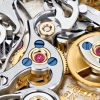-
Recently Browsing
- No registered users viewing this page.
-
Topics
-
Posts
-
This is a very valid point and a subtlety that I was unaware of until fairly recently, learning all the time, the video below explains this point well:
-
By HectorLooi · Posted
You don't have to use his special tester. Any good multimeter would work. -
By nevenbekriev · Posted
Yes, it looks like GT Revue 30. Doctor, You can not replace escape wheel by the dimensions You listed. One needs to know much more things like number of leaves of the pinion and it's diameter, the position in high of the table and the pinion, the hight between the pivots, the exact pivots diameter... And then, even if suitable wheel is found, one will need to know how to adjust the pallets position correctly. Restoring antique movements is something different than replacing parts. In older movements parts are not interchangeable, this means spare parts do not exist. Here the case is different, but still escapement adjustment will be needed if a wheel from a donor is found. So may be it will be easier to restore the donor for You...Restoring antique movements usually means making of the parts needed and this requires knowlage and working on lathes skill. In this case repivoting of the wheel is the natural solution, but there is a long way that one must walk untill getting ready for such work. -
I was looking at Essence of Renata, a chemical used a lot for cleaning hairsprings: "Specially prepared solution for degreasing watch and instrument components. Indispensable for degreasing hairsprings." Looking at the MSDS you can see this is just pure n-Heptane, so could be an option for those who don't want to use the chlorocarbons or hexane? HF6013 - Horological Essence COSHH Safety Data Sheet Horological Essence_0.pdf
-






Recommended Posts